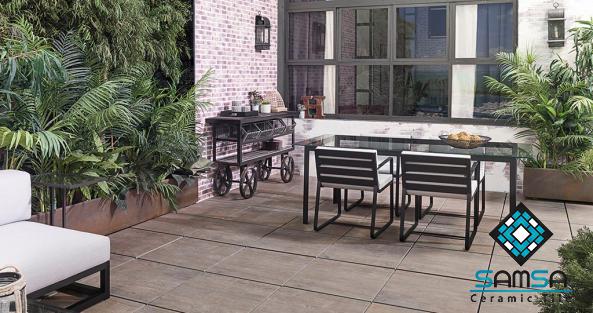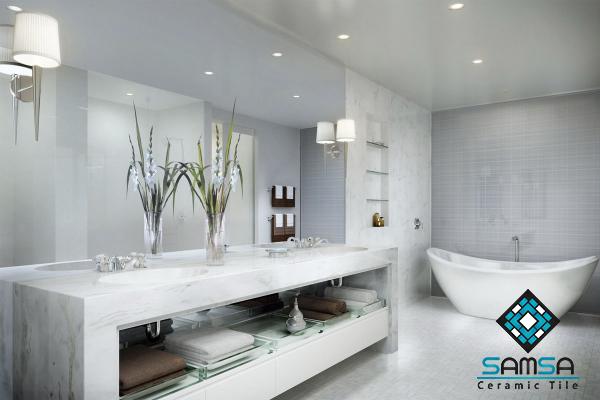Nowadays, because of the durability and beautiful texture of patio tiles, the sale of patio tiles varieties is booming, because many people are willing to buy stylish patio ceramic tiles. While patio ceramic tile types and indoor floor and walls almost use the same ceramic, there are subtle differences between them, like the ability to withstand a wide range of temperatures and bad weather, so we should be careful to buy patio ceramic tiles at valid stores.

Different Types of Patio Ceramic Tiles
 Buying patio ceramic tile can be an exhaustible task if we don’t know exactly what we want, for example, some prefer elegant light ceramic tiles over some rough inelegant ceramic, others live in a rainy environment, so it’s best for them to buy non-slippery ceramic tiles; in the end, it all depends on your preferences and where you live.
Buying patio ceramic tile can be an exhaustible task if we don’t know exactly what we want, for example, some prefer elegant light ceramic tiles over some rough inelegant ceramic, others live in a rainy environment, so it’s best for them to buy non-slippery ceramic tiles; in the end, it all depends on your preferences and where you live.
If you care more about the aesthetic aspect of the patio, porcelain offers a simple look that has a solid color, traditional ceramic tiles also come in different colors, the quarry types are brown and some of them resemble wood, granite has a lot of small white dot on its surface if that’s something you like.
Apart from being stylish, we also need to keep in mind that durability is an important feature of ceramic before buying; natural stones are quite durable, one of the most famous natural stones that it’s famous for being hard is granite which is incredibly enduring. Another type is limestone with a pale brown color. Travertine is another hard stone that is considered a type of limestone and its surface is pitted so it may collect dirt.
Naturally, because of the dirt and dust of the tiles that collected over time, ceramic tiles are non-slippery; but when it rains, they can be slippery; so, for rainy environments, it’s very essential to choose tiles that are not slippery, porcelain, quarry, travertine, and granite are slippery if they are wet.
Tips That Should Be Observed While Painting Ceramic Tile
 People have different reasons for painting ceramic tile. Some people rather paint their old tiles to conceal their poor shape, others paint to make them look luxurious without the hassle of replacing them all. Not only it’s better for some tiles that are strongly attached to concrete, and it’s difficult to take them out, it’s also way less expensive.
People have different reasons for painting ceramic tile. Some people rather paint their old tiles to conceal their poor shape, others paint to make them look luxurious without the hassle of replacing them all. Not only it’s better for some tiles that are strongly attached to concrete, and it’s difficult to take them out, it’s also way less expensive.
To extend the endurance of the paint on the tiles, there are some things that we need to do, for example, extended exposure to water and moisture will cause the paint to peel off gradually, so it’s better to either choose a dry area or choose paint labeled specifically for wet areas.
It is crucial to clean ceramic tiles before painting. To clean thoroughly, the surface of the tiles should be removed from any dust, dirt, oil, grease, mold, or anything that prevents the paint from adhering to the surface of the tiles. By using a brush and hot water+bleach, we can completely clean any germs that are between the lines of the tiles.
Patio Ceramic Tiles for Sale
Multiple factors determine the price of ceramic tiles price, availability, appearance, and durability are all elements of pricing; the more thick and hard the tiles are the pricier they become.
Many ceramic tiles such as porcelain and normal ceramic use clay; thus thick tiles cost more because they are fired more than thin ceramic in a high-temperature furnace, so more fuel is used.
Some tiles have printed pictures on them, the quality of them varies, but high-resolution printed tiles need more color and a precise device which leads to an increase in expenses.
Another factor is the difference in texture between each tile, all tiles have a rating from V1 to V4; V1 means every tile looks exactly like the other; V2: there are some minor changes in some tiles; V3: have some substantial changes either in color or pattern; V4: each tile is totally different.










Your comment submitted.